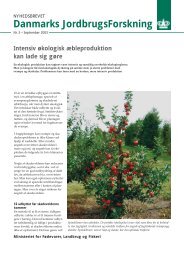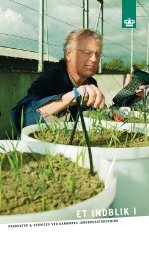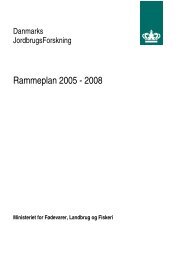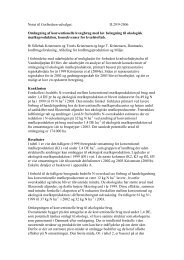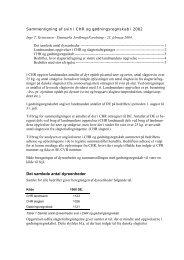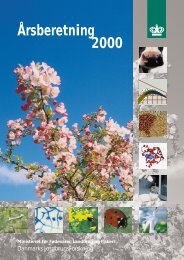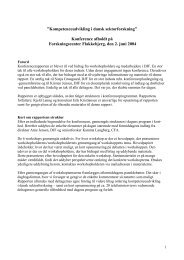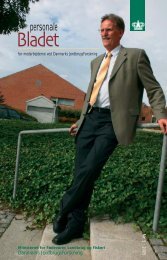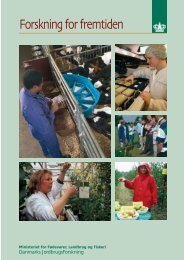Reproduction performances and conditions of group-housed non ...
Reproduction performances and conditions of group-housed non ...
Reproduction performances and conditions of group-housed non ...
Create successful ePaper yourself
Turn your PDF publications into a flip-book with our unique Google optimized e-Paper software.
Paper II<br />
- Summary -<br />
A review <strong>of</strong> 15 experiments with <strong>group</strong> <strong>housed</strong> sows showed that there are indications that<br />
stress <strong>and</strong> fear might be contributing reasons for the impaired reproduction seen in some<br />
<strong>group</strong> <strong>housed</strong> sows. Possible initiators <strong>of</strong> stress <strong>and</strong> fear might be mixing <strong>of</strong> unfamiliar<br />
sows <strong>and</strong> high stocking rates. Traditional methods for assessing stress <strong>and</strong> fear are expen-<br />
sive <strong>and</strong>/or time consuming <strong>and</strong> therefore difficult to use in large-scale on-farm studies or<br />
as components in a management tool to analyse <strong>and</strong> improve the reproduction performance<br />
in <strong>group</strong> <strong>housed</strong> sows. Therefore, based on existing knowledge, possible indicators <strong>of</strong><br />
stress <strong>and</strong> fear related reproduction problems suitable for use in practice were put forward<br />
in the paper. However, whether these indicators were suitable to express variation in sows<br />
susceptibility for a good reproduction performance under practical <strong>conditions</strong> was not<br />
known.<br />
Paper III<br />
Experimental studies have indicated that <strong>group</strong> housing may lead to individual variation in<br />
feed intake, fear <strong>and</strong> social stress. However, systematic information <strong>of</strong> between-herd <strong>and</strong><br />
within-herd variation in feed intake, fear <strong>and</strong> social stress in sows <strong>group</strong> <strong>housed</strong> under<br />
various <strong>conditions</strong> is lacking. Most likely, this is to some extent because <strong>of</strong> a lack <strong>of</strong> suitable<br />
assessment methods. With the aim to evaluate indicators <strong>of</strong> feed intake, fear <strong>and</strong> social<br />
stress <strong>and</strong> to get insight in the level <strong>and</strong> variation in these indicators in <strong>group</strong> <strong>housed</strong> sows<br />
under various on-farm <strong>conditions</strong>, a farm study took place including 14 commercial herds<br />
followed in 11 month. The results showed that back fat, skin lesions <strong>and</strong> behavioural<br />
measurements might be relevant indicators <strong>of</strong> the condition <strong>of</strong> the sows regarding feed<br />
intake, stress <strong>and</strong> fear at herd, batch, <strong>and</strong> individual sow level in commercial herds with<br />
<strong>group</strong> <strong>housed</strong> <strong>non</strong>-lactating sows. For almost all indicators the variation between herds was<br />
larger than the variation between batches within herds. However, the largest contribution to<br />
the variation came from the variation between the individual sows. The between-sow<br />
variation in back fat at farrowing was significantly higher in herds with <strong>group</strong> feeding than<br />
in herds with individual feeding. The study indicated that <strong>group</strong> feeding may lead to overfeeding<br />
<strong>of</strong> high ranking sows <strong>and</strong> severe underfeeding <strong>of</strong> a few low ranking individuals.<br />
The presence <strong>of</strong> feeding stalls reduced the level <strong>of</strong> aggressions the first hour after weaning.<br />
Irrespective <strong>of</strong> layout, sows older than third parity were involved in most aggressions the<br />
first hour after mixing on the day <strong>of</strong> weaning. However, three weeks after mating <strong>and</strong> at<br />
farrowing, these sows had the lowest level <strong>of</strong> skin lesions indicating that any stress experienced<br />
by these old sows was short-lasting. In herds with no escape possibilities, first parity<br />
sows had the highest level <strong>of</strong> skin lesions three weeks after mating <strong>and</strong> at farrowing,<br />
whereas in herds with escape possibilities, second <strong>and</strong> third parity sows had the highest<br />
level. Herds with electronic sow feeding <strong>and</strong> large dynamic <strong>group</strong>s had the highest average<br />
level <strong>of</strong> skin injuries.<br />
2




